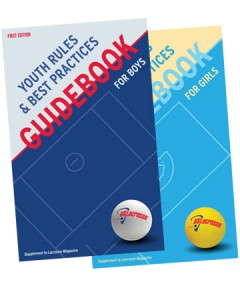The Five Big Things Every Lacrosse Parent Should Know
 This article by Matt Forman appears in the October issue of Lacrosse Magazine, the flagship publication of US Lacrosse. Don’t get the mag? Join US Lacrosse and its 400,000-plus members today to start your subscription.
This article by Matt Forman appears in the October issue of Lacrosse Magazine, the flagship publication of US Lacrosse. Don’t get the mag? Join US Lacrosse and its 400,000-plus members today to start your subscription.
Dr. Richard Ginsburg took a deep breath and chuckled. “Being a parent is humbling,” said Ginsburg, the co-director of the Paces Institute for Sport Psychology at Massachusetts General Hospital in Boston, faculty member at Harvard University, US Lacrosse Sports Science and Safety Committee member and co-author of “Whose Game Is It, Anyway?”
“As a parent, I’m getting more and more data on myself. I’m amazed at how many mistakes I’m making, and how often I can get swept up in the very things that I’m warning parents about. I’ve studied this, and I’ve written books about it. And I still find myself vulnerable to these things,” Ginsburg said.
“It’s hard work. No one is perfect here. Ninety-nine percent of parents are well-intentioned, and we’re not crazy, bad people. But there’s so much pressure in the culture, and we can get pulled in a lot of directions. It’s hard to keep it together. We’re going to make mistakes as parents, and that’s OK, as long as we learn from our mistakes and try to re-center ourselves by reviewing our values.”
We’ll make this the first observation: Check your ego at the door. It’s hard — for everyone.
The second observation: There are no hard-and-fast rules. Every child is different. Every parent is different. Every situation is different.
When Lacrosse Magazine embarked on an adventure to compile advice to help parents navigate the youth lacrosse experience by getting the opinions of more than a dozen influential figures across the game, we didn’t know where it would take us. So what did we find? No one has all the answers.
“I tell parents and kids: ‘Listen, I have no idea what I’m talking about right now. And I know you have no idea what I’m talking about right now,'” said Duke men’s lacrosse coach John Danowski, who has been on all sides of the parent-child-coach triangle. “If we can all agree that we have no idea, then at least we have a base to start from. At least we can say, ‘All right, we’re all kind of clueless. Let’s start from there.'”
We’re here to help. Acknowledging that parenting is challenging and there are no definitive guidelines, Lacrosse Magazine settled on five underlying principles that can help parents steer through the youth lacrosse experience. What follows are five things every lacrosse parent should know.
1. There is no pot of gold at the end of the recruiting rainbow
Ruthie Lavelle, mother of five and president of the Maryland Youth Lacrosse Association, a volunteer-based recreational league of about 40,000 boys and girls ages 5 to 14, said parents have lost perspective in their decision-making because of recruiting, the process for which has been hastened remarkably in recent years. “What are parents chasing? They’re chasing disappointment,” Lavelle said. “They think there’s a pot of gold, but they’re chasing dissatisfaction. They’re crazed about it.”
Parents vigorously pursue and make great sacrifices — in time, finances and energy — in a competitive quest, hoping to capture an athletic scholarship. The return on investment is not what you think.
“The current culture is suggesting, ‘If you just get the right coach, and play in the right program, and play enough hours, you can be great. And you have to pay for it,'” Ginsburg said. “But the reality is — if you do the math — there are going to be many disappointed people.”
In 2012, there were 61 men’s Division I programs, and 92 women’s programs. For men, the NCAA maximum number of allowable scholarships is 12.6 over four years. For women, it’s 12. Estimates suggest roughly half of these programs are fully funded; some schools have fewer than the allotted total, while Ivy League and service academies do not offer athletic scholarships.
These scholarships most often are divided among players. Denver Outlaws coach Jim Stagnitta, the former Rutgers men’s coach and current owner of MVP Lax Camps, joked: “I can think of a handful guys who got full rides, and most of them are named Powell.”
Said Virginia men’s coach Dom Starsia: “If you take our Tewaaraton Award winners — Matt Ward, Chris Rotelli and Steele Stanwick — and added them all together, it might equal a little more than one full scholarship.”
Said Georgetown women’s coach Ricky Fried: “There’s a misconception of the full ride. They’re just not out there.”
Any high school athlete has a 6-percent chance of playing college varsity sports in any division and 3.7-percent chance in Division I, according to a recent Wall Street Journal article.
“What happens when an athlete has put all his eggs in one basket? It creates a risk of imbalance,” Ginsburg said.
- As part of US Lacrosse’s effort to develop consistent national rules, the organization developed gender-specific guidebooks to help explain the rules and the rationale behind them.
 2. The rules of the game — and why they exist
2. The rules of the game — and why they exist
Lacrosse has been called the fastest sport on two feet, and the fastest-growing sport in the country. The result? With an increasing number of new people being introduced to the fast-paced game for the first time, there’s uncertainty about the rules that govern the game, and why they’re in place. Sometimes, this can be frustrating and lead to unsportsmanlike behavior — most notably vocal displeasure — from parents on the sidelines.
Chase Howse, US Lacrosse Youth Rules Committee chair, spent 35 years playing lacrosse and the last 30 officiating the game. His message to parents: “Take whatever time and steps you feel necessary to learn the rules before your son or daughter steps on the field. Is he or she learning from his coaches during practice? Or is it from watching a bunch of fouls being called during a game — often accompanied by howls of displeasure from coaches and fans?”
US Lacrosse, in conjunction with its Sports Science and Safety Committee, in 2012 released the Youth Rules and Best Practices Guidebooks. As part of the organization’s effort to develop consistent national rules based on the physical, cognitive and psychological development stages of children, US Lacrosse developed these gender-specific guidebooks to help explain the rules and the rationale behind them. The three golden principles: safe, fun and fair.
A reminder from Cathy Russo, US Lacrosse Girls Youth Rules Interpretation chair: “Our No. 1 priority is always to keep the players safe.”
The guidebooks — along with the website uslacrosse.org — provide a tremendous foundation from which to learn about the game.
Beyond reading the rulebook, US Lacrosse officials and education manager Lucia Perfetti Clark said, “The best way to learn the game is to get out there and do it; some of the best officials are parents.” Russo and Clark suggested attending an officials/umpires training course or rules interpretation session, which are often offered through US Lacrosse chapters or affiliated youth organizations.
These sessions can help clarify the most misunderstood rules of each gender’s game — which, it should be noted, are significantly different.
On the boys’ side, the least understood rules revolve around contact, and there’s varying amounts of legal contact allowed at every level of the game. At higher levels, the loose ball push versus push with possession leads to confusion. On the girls’ side, shooting space violations and three-second held ball calls are most bewildering.
“In both games, even if a call goes against your team or kid, be happy when officials make calls for safety,” Perfetti Clark said.
“And remember, we’re all part of the same team,” Howse said. “We’re all in this together. We’re all responsible for creating a positive environment, and we share a big responsibility for imparting a solid sense of the culture of our game to the kids that learn to play — and love.”
3. The hazards of sport specialization
Dom Starsia has developed a reputation. He gets cold calls from coaches and players across the country suggesting their linebacker or point guard might make a great lacrosse player. Starsia, who played football and lacrosse at Brown, is an advocate of multi-sport participation, in an era where media hype is driving parents in the direction of sport specialization.
“As the game spreads and there’s more press coverage and more popularity and more opportunities to profit, you’re seeing a greater emphasis on the belief that, ‘The earlier the better, the more the better,’ of anything, of any sport, of any academic endeavor,” Ginsburg said. “But there’s not really any definitive evidence that indicates specializing is going to lead to better performance.”
Which is why Starsia has gone after players like Chris LaPierre, a former Shawnee (N.J.) High football star who had played lacrosse in the summers for fun, and now is one of the nation’s most dynamic players. The Cavaliers’ short-stick defensive midfielder was named a second-team All-American in 2012 and in September was tabbed Virginia’s first solo team captain of the Starsia era.
“There is nothing you can be doing in lacrosse on your own in the fall that would be better for you than going to football or soccer practice every day,” Starsia said. “You can go bang a ball against a wall all you want, but how do you become a better team player? By playing other team sports.”
Becoming coachable, paying attention to detail, understanding the importance of preparation, working toward a goal, understanding your role and evaluating your performance from playing other sports are “such a huge advantage,” Danowski said. “Playing club lacrosse once a week, I don’t know if that it’s the same.”
“You have one time to leave a legacy at your school. You have one time to take advantage of putting on a football helmet or playing soccer,” Danowski continued. “When you look back at your school yearbook 40 years from now, would someone say, ‘Yeah, that guy was a lacrosse head?’ Playing other sports helps develop a wealth of confidence that doesn’t come from playing in a meaningless club game in November.”
Ginsburg said sport specialization can lead to burnout, overuse injury and fragmentation of friendships. Conversely, participating in multiple sports also helps children develop muscularly, in what four-time U.S. women’s national team player Danielle Gallagher, the founder and president of the Long Island Liberty lacrosse club, called “a cross-training theory.”
Fried added sport specialization leads to a general lack of “being a kid… Creativity starts to fade away.”
4. How to be a good consumer of your child’s lacrosse experience
Determining the appropriate level for engagement in your child’s experience is tricky, and it’s often age-dependent. But at any level, it’s important for parents to be good consumers. The best way to do so: Ask respectful but pointed questions — of your child, of programs and teams you’re considering, and of objective third parties. Related, do your homework and research as much as possible. Don’t sit back and wait to learn these things after the fact; actively seek out information.
“This is going to sound really stupid simple,” Johns Hopkins women’s lacrosse coach Janine Tucker said.
“It truly is about communicating with your child.”
“Communication is critical, but it’s also paying attention to the signs, listening to coaches and parents who have interaction with out children, getting a sense from them about how our kids enjoy the sport,” Ginsburg said. “Do they enjoy it? Are they excited and energetic? Are we seeing them complaining about going to practice?”How well do you know your son or daughter? What is your child capable of athletically? When are they happiest? What’s most important to your child? What does your child actually want to do?
What is the age-appropriate level for my child? How competitive are the various levels of play — recreation programs, travel teams, tournaments and club programs? What are the time commitments for each? Several coaches suggested playing at a level where you can learn but contribute.
What is a coach’s philosophy? Is the coach certified? Have they had a background check? What are their experiences and background?
How stable is this program? What is a program’s philosophy? How many players are on each team? Are there multiple teams within each program? Do kids get equal playing time? The set-up of a program will entirely determine a child’s experience for a season.
“Stability of the organization and coaching are two of the most important factors,” Lavelle said. “If it’s a well-managed league or program, that should first or foremost be a priority.”
Are the officials trained and certified? Do they go to training every year? Will the games, tournaments and events have at least two officials at every game? Are safety precautions in place?
How many games/practices in one day, or one weekend, will a team or event require? Are there trainers on site? Will the teams stay in air-conditioned dorms?
And lastly: How much does all this cost? What is financially feasible for your family? The cumulative cost of playing for a club team and participating in recruiting tournaments can quickly exceed $10,000, especially with programs starting at such young ages. To what end is this money being spent?
Ginsburg suggests evaluating these types of questions on a seasonal basis. He also says having a non-invested third-party can help provide feedback or perspective.
“It’s really important that parents have objective adult allies who can help give a sense of perspective,” Ginsburg said. “To have an adult — someone with nothing invested in giving you feedback — say this kind of experience would be valuable for your kid is helpful. We need that kind of additional, objective feedback that we respect.”
Sure, that’s a lot of questions to ask. But if you haven’t considered them — or don’t know the answer to them — you haven’t done your homework. Approach it like any other significant investment you make.
5. How your behavior affects that experience
Parents are equally as important to a child’s positive lacrosse experience as the coach of the team, or the league they play in. Attend games, but be supportive and not overbearing. Positive reinforcement encourages learning and fun. Research has shown that a ratio of five positive statements — compliments and positive recognition — for each negative statement — criticisms and corrections — is ideal for helping young athletes do their best.
But too much external praise can hinder the maturation process. “One-third of my speaking engagements are to businesses. Managers say young workers don’t know what to do unless someone else tells them,” said Madeline Levine, a psychologist and the co-founder of Challenge Success, a project born at the Stanford School of Education. “They need to be told every day that they’re doing well instead of once a year.”
Negative parental behavior also can have an adverse effect on the recruitment of a child. High school lacrosse players far outnumber opportunities available. Stagnitta, a former Division I coach at Rutgers and Division III coach at Washington & Lee, said college coaches “look for reasons not to recruit guys.”
The negative behavior parents engage in that’s most alarming to coaches on the recruiting circuit: unsportsmanlike sideline conduct.
“Coaches are always aware of parents’ behavior on the sidelines,” Stagnitta said. “It’s one of the first questions they ask. You’re sitting there and you see parents doing that, and you know it’s a four-year hitch. There’s enough guys out there, the character of the parents and the personality and how they conduct themselves and how they interact with the coaches and how they act on the sidelines, in a lot of ways, is going to carry as much weight as the player. All things being equal, you’re going to go with the kid who has the most character as a family.”
Said Fried: “On the sidelines, how are parents talking to their daughter, or the other players? We want parents who are supporting their kid and their team. What about the way they’re interacting with officials? Are they talking to other people, or are they off to the side by themselves? After the game, are the parents going over stats or what their kid did individually? Those behaviors are the most recognizable.”
It’s about balance. It’s about positive but not constant reinforcement. And it’s not about you. It’s about your child.
INSIDE THE NUMBERS Men’s Lacrosse
Women’s Lacrosse
Sources: NCAA, US Lacrosse data from 2011-12 and estimated projections based on Lacrosse Magazine research |




















